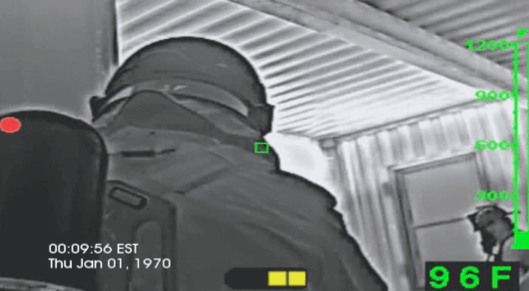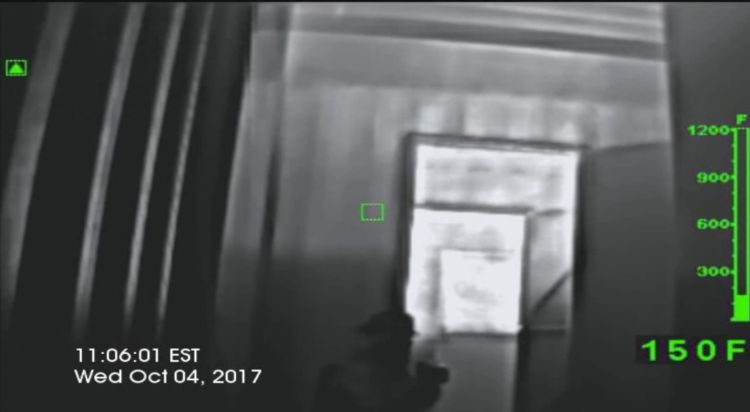The Power of Grey Scale:
With the recent release of UL’s research paper on “Evaluation of Thermal Imaging Camera Spot Temperature Measurements in Structure Fires” (see link below)
https://drum.lib.umd.edu/handle/1903/25361
We have had many discussions with fire service professionals on two very important topics in thermal imaging:
- Color Palettes
- The Spot Temperature

Firefighters need to understand the power and the value of each of these concepts. Notice in the following video, the firefighters are seated around the corner from a fire room. Without proper training and understanding, a firefighter would be inclined to think they are in a low temperature environment. However, this is not the case. When assessing thermal severity, we consider all cues & clues not just the thermal indicators.
In this particular case, this camera doesn’t switch to Low Sensitivity until 2% of the measured area is over 240 Degrees Fahrenheit. In this case, the spot temperature measurement is focused on the firefighters and not the superheated areas above their heads. Notice the white areas (this is a sign of heat in this camera) and notice the subtle convection currents that could easily be missed if we scan too fast.

In addition, this particular TIC doesn’t show colorization until 500 degrees Fahrenheit. Many fire service TIC instructors believe strictly in grey scale. This is an increasing issue with firefighters due to the following reasons.
- Firefighters are not properly trained nor educated in TIC use overall
- Firefighters don’t respond to grey scale especially if they are not trained in their particular TIC and its corresponding color/temperature correlations.
- The human eye can differentiate 30 shades of gray when not under stress but only 4 shades of grey when under stress. Therefore, having an area that is colorized is important to highlight areas of importance.
NFPA 1801: Standard on Thermal Imagers for the Fire Service-chapter 6.6.4.1.9 states in regard to colorization the following:
In the TI BASIC mode, the heat color reference bar shall have a color scale that includes only the following colorization:
(1) Greyscale — at the bottom of the heat color reference bar before color indication begins and shall not be more than 50 percent of the overall height of the heat color reference bar.
(2) Yellow — at the low end of the heat color reference bar
(3) Orange — in the middle of the heat color reference bar
(4) Red — at the high end of the heat color reference bar
In addition to this data, if the TIC is outside of its range (distance to spot ratio) it will not switch to Low sensitivity or show colorization until its within the proper distance to the target. Other variables that affect measurement are atmospheric attenuation such as:
- Overall optical density of the smoke
- Moisture content
- Emissivity of the surface area
This data and more confirms the need for more education for firefighters BEFORE using a fire service TIC in a fire. In fact, NFPA 1408 Standard for Training Fire Service Personnel in the Operation, Care, Use, and Maintenance of Thermal Imagers states that firefighters shall do the following:
•4.1.1 A TI training program shall be implemented.
•4.2.1 The AHJ shall establish written policies for TI training that meet the requirements of this standard.
•4.2.2 The policy shall address the training requirements for types of incidents where TIs may be used.
•4.2.3 The training policy shall include an annual review of member competence in TI technology, operation, application, use and limitations, care and maintenance.
•4.2.4 TI training shall include practical evolutions, using TI
•4.2.6* The training program shall include both individual and crew training.
•4.2.7 Members shall be provided with TI training and education before being permitted to operate TIs per AHJ.
•4.2.7.1* Before new or unfamiliar TIs are placed into service, training and education relating to those imagers shall be provided for all affected members.
•4.2.8 Members shall be provided with classroom education and hands-on familiarization in TI functions before being permitted to operate TIs in IDLH atmospheres.
So let’s ask ourselves?
How well do we understand OUR thermal imaging camera?
How much training and education have we had in practical and live fire scenarios with OUR thermal imaging camera?
Each fire service TIC switches from high to low sensitivity at different temperatures. Each fire service TIC shows colorization at different color/temperature correlations and some show color in each sensitivity mode. Each fire service TIC is different which requires individual and specific training on that device BEFORE we can become proficient with it.
Be Intelligently Aggressive and lets stay well trained and educated on all of our tools.
Instructor Andy Starnes
Insight Training LLC
Level II Thermography Certified

